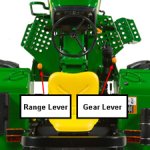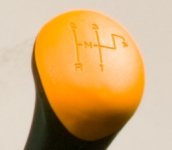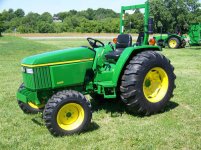RoyJackson
Rest in Peace
- Joined
- Nov 17, 2001
- Messages
- 23,144
- Location
- Bethel, Vermont
- Tractor
- John Deere 4052R Cab,, Deere 855D UTV, Z920A Zero Turn Mower and assorted implements
When all else fails, read the manual...
Operating the Collar Shift Transmission
The machine may be operated in any gear with engine speeds between 925 rpm and 2920 rated engine rpm. Within these limits, the engine can be placed under varying load operations.
Gear shift lever (A) provides three forward speeds: 1, 2, and 3, N (neutral), and one reverse speed, R. Forward speeds may be changed while tractor is in motion if clutch pedal is depressed. Stop tractor and depress clutch before changing direction.
Range shift lever (B) provides three speed ranges: A, B, and C, and N (neutral). Use decal (C) on the left fender as a guide. Tractor should be stopped and clutch depressed before changing speed ranges.
Using both the transmission gear and range shift levers in different combinations, nine forward and three reverse speeds can be achieved.
The gear shift lever must be in NEUTRAL for the engine to start.
1. Depress and hold down clutch pedal and stop machine motion before attempting to shift range shift lever.
2. Place gear shift lever in the N (neutral) position.
3. Choose A, B, or C speed range on range shift lever to match work application:
A High power/low speed operations such as tilling hard soil, mowing high grass, positioning backhoe, etc.
B Operations including moderate tilling, hauling, and grass mowing.
C High speed operations such as transport and light mowing.
1st Gear High power, low speed operations.
2nd Gear Medium power, moderate speed operations.
3rd Gear Low power, high speed operations.
Reverse Backing up and positioning operations.
5. Raise engine speed to match expected loads. If a slight increase in engine rpm occurs simultaneously with moving hand throttle lever forward, the engine is not overloaded.
So, the transmission is synchronized, at least in the foward gears
Operating the Collar Shift Transmission
The machine may be operated in any gear with engine speeds between 925 rpm and 2920 rated engine rpm. Within these limits, the engine can be placed under varying load operations.
IMPORTANT: Avoid damage! To prevent transmission damage:
Depress clutch pedal and stop machine motion completely before shifting the range shift lever.
While operating machine, always depress clutch pedal and stop machine motion before changing travel gears.
Never rest a foot on the clutch pedal while machine is in motion.
Depress clutch pedal and stop machine motion completely before shifting the range shift lever.
While operating machine, always depress clutch pedal and stop machine motion before changing travel gears.
Never rest a foot on the clutch pedal while machine is in motion.
Gear shift lever (A) provides three forward speeds: 1, 2, and 3, N (neutral), and one reverse speed, R. Forward speeds may be changed while tractor is in motion if clutch pedal is depressed. Stop tractor and depress clutch before changing direction.
Range shift lever (B) provides three speed ranges: A, B, and C, and N (neutral). Use decal (C) on the left fender as a guide. Tractor should be stopped and clutch depressed before changing speed ranges.
Using both the transmission gear and range shift levers in different combinations, nine forward and three reverse speeds can be achieved.
The gear shift lever must be in NEUTRAL for the engine to start.
1. Depress and hold down clutch pedal and stop machine motion before attempting to shift range shift lever.
2. Place gear shift lever in the N (neutral) position.
3. Choose A, B, or C speed range on range shift lever to match work application:
A High power/low speed operations such as tilling hard soil, mowing high grass, positioning backhoe, etc.
B Operations including moderate tilling, hauling, and grass mowing.
C High speed operations such as transport and light mowing.
IMPORTANT: Avoid damage! Never overload the engine. Select the proper gear and engine speed for the job:
For light load operation, use higher gear and lower engine speed.
For heavy load, use lower gear and higher engine speed.
4. Choose a gear on gear shift lever that matches the immediate power/speed requirements: For light load operation, use higher gear and lower engine speed.
For heavy load, use lower gear and higher engine speed.
1st Gear High power, low speed operations.
2nd Gear Medium power, moderate speed operations.
3rd Gear Low power, high speed operations.
Reverse Backing up and positioning operations.
5. Raise engine speed to match expected loads. If a slight increase in engine rpm occurs simultaneously with moving hand throttle lever forward, the engine is not overloaded.
IMPORTANT: Avoid damage! Never rest a foot on the clutch pedal while driving the machine.
6. Release clutch pedal gradually to take up load smoothly. So, the transmission is synchronized, at least in the foward gears





